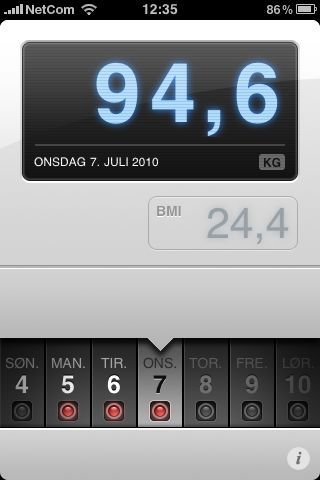I train a couple of times a week and the only way I am able to do that is by doing it nurd-style. I use a lot of apps to record my training sessions and gather statistics. Not only is it helpful, but more importantly it works as motivation. I basically use three different apps. One to track my weight (more interesting than useful perhaps), one to track my wight training and help it and one to track my cycling and running (actually there are two, but I’ll come back to that later). I use an iPhone and I’m not sure if all the apps are available on other platforms.
The first app is WeightBot which let me track my weight. It doesn’t do it automatically (unless you have this 160$ weight..), I have to manually enter my weight every day. You can set a target weight and how many days to achieve that goal. You get a nice graph and you can view it by week, month or year. It also gives you a BMI or Body Mass Index, but it may or may not be accurate, depending on how fit and how much muscle mass you have.
I have to admit I use it more out of a curiosity than as a tool to actually lose or gain weight. You’ll be surprised how a weekend of partying and drinking affects your body…
GymGoal
GymGoal is your substitute to pen and paper at the gym. You can choose from a mixture of pre planned training programs or make your own custom ones. The app has a library of hundreds of different exercises, using free weights, cables, machines or just your own body. Each exercise is shown by a step by step walkthrough. Keep a record of your training sessions, how long they last, how much you lift, how many sets and so forth. Make notes to your self and time your breaks in between sets. There is even information about nutrition and how to reach your goal, whether it is muscle-building, weight loss, stamina or endurance.
Of all the training apps I’ve come across, GymGoal is the most extensive one, covering almost all aspects related to indoor gym training. You can also back up your information to a server in case you lose or have to restore your phone. It even has a built-in music player, though you can use Spotify, Wimp or the iPod in the background.
Cyclemeter
Cyclemeter is one of many GPS tracking apps in the App Store and I have not tested all of them. It’s similar to MotionX GPS, but without all the annoying sounds and
all the useless graphics bullshit. Cyclemeter gives you all the obvious functions of course, a map, graphs, average speed, max speed, time, altitude and so forth. You can automatically send updates to Twitter, Facebook and email. Cyclemeter can even read any replies you get out loud if you use earplugs while cycling (which I don’t recommend).I don’t see the use of this, unless you are doing something crazy like cycling from Trondheim to Oslo. Then your friends or anyone else remotely interested could keep track of your progress and encourage you underway. I would say the main purpose is to save your trips and over time improve your time and speed. There is also a nice calendar that shows all your trips and whether they were better or worse than previous trips.
Cyclemeter can of course be used for other things than biking, like running, walking, skating, skiing or swimming(!), but for some reason there is apps for that as well. I guess there is economic gain in having three identical apps, but with different names and icons..
The last app I use is the Nike+ app for running indoors, on a treadmill . Free to download, but requires the Nike+ sensor in, or on, your shoe. It works well, but the results never quite match the ones on the treadmill itself. What makes Nike+ cool is the web-integration. Set goals, look at you running history, compare times, pace and length of your runs. It has turned out to be a nice community and it’s excellent if you’re a group of people training together, whether your competing or not 🙂




